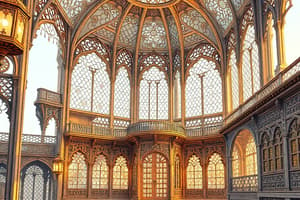Podcast
Questions and Answers
Which aspect is NOT a consideration understood through structural systems in architectural design?
Which aspect is NOT a consideration understood through structural systems in architectural design?
What is the primary function of a substructure in a building?
What is the primary function of a substructure in a building?
How do structural systems relate to the ordering of human activities within a building?
How do structural systems relate to the ordering of human activities within a building?
Which characteristic is least influential in the design of a building's substructure?
Which characteristic is least influential in the design of a building's substructure?
Signup and view all the answers
What role do sensory and cultural characteristics of place play in structural systems?
What role do sensory and cultural characteristics of place play in structural systems?
Signup and view all the answers
Which of the following describes the relationship between buildings and their natural environment?
Which of the following describes the relationship between buildings and their natural environment?
Signup and view all the answers
What is the significance of scale and proportion in structural design?
What is the significance of scale and proportion in structural design?
Signup and view all the answers
What factor is critical in determining the type of substructure chosen for a building?
What factor is critical in determining the type of substructure chosen for a building?
Signup and view all the answers
What are the two major components of a structure?
What are the two major components of a structure?
Signup and view all the answers
Why is structural analysis important in designing a structure?
Why is structural analysis important in designing a structure?
Signup and view all the answers
Which of the following best distinguishes structural systems in building design?
Which of the following best distinguishes structural systems in building design?
Signup and view all the answers
What is the primary focus during structural system planning?
What is the primary focus during structural system planning?
Signup and view all the answers
Which of the following concepts is NOT typically considered in the building design process?
Which of the following concepts is NOT typically considered in the building design process?
Signup and view all the answers
How do structural systems impact the built environment?
How do structural systems impact the built environment?
Signup and view all the answers
Which part of a structure does the substructure primarily consist of?
Which part of a structure does the substructure primarily consist of?
Signup and view all the answers
What role do structural connections play in a building's design?
What role do structural connections play in a building's design?
Signup and view all the answers
What is the main topic of PQUIZ NO. 1?
What is the main topic of PQUIZ NO. 1?
Signup and view all the answers
When is PQUIZ NO. 2 scheduled to take place?
When is PQUIZ NO. 2 scheduled to take place?
Signup and view all the answers
Who is the course instructor for CE013 in the 1st semester of 2024-2025?
Who is the course instructor for CE013 in the 1st semester of 2024-2025?
Signup and view all the answers
Which module will PQUIZ NO. 2 cover?
Which module will PQUIZ NO. 2 cover?
Signup and view all the answers
What is the format of the quizzes mentioned in the announcement?
What is the format of the quizzes mentioned in the announcement?
Signup and view all the answers
What is the primary function of shallow foundations?
What is the primary function of shallow foundations?
Signup and view all the answers
Which of the following is a geometric form that shallow foundations can take?
Which of the following is a geometric form that shallow foundations can take?
Signup and view all the answers
What distinguishes deep foundations from shallow foundations?
What distinguishes deep foundations from shallow foundations?
Signup and view all the answers
What comprises the superstructure of a building?
What comprises the superstructure of a building?
Signup and view all the answers
What is the role of the building shell?
What is the role of the building shell?
Signup and view all the answers
How do external walls and roofs contribute to a building's environment?
How do external walls and roofs contribute to a building's environment?
Signup and view all the answers
What is the relationship between the superstructure and the substructure during construction?
What is the relationship between the superstructure and the substructure during construction?
Signup and view all the answers
What type of soil conditions are deep foundations intended to address?
What type of soil conditions are deep foundations intended to address?
Signup and view all the answers
What factors influence the choice of a structural system in building design?
What factors influence the choice of a structural system in building design?
Signup and view all the answers
Which factors are regulated in relation to a building's size and intended use?
Which factors are regulated in relation to a building's size and intended use?
Signup and view all the answers
In what way do zoning ordinances impact building design?
In what way do zoning ordinances impact building design?
Signup and view all the answers
What should be considered to accommodate future growth in building design?
What should be considered to accommodate future growth in building design?
Signup and view all the answers
What is one key attribute that should be incorporated into the design process for structural systems?
What is one key attribute that should be incorporated into the design process for structural systems?
Signup and view all the answers
What does the regulated relationship between building size and intended use signify?
What does the regulated relationship between building size and intended use signify?
Signup and view all the answers
Why are minimum required distances from the building to property lines established?
Why are minimum required distances from the building to property lines established?
Signup and view all the answers
How might the projected scale of a building affect its structural system requirements?
How might the projected scale of a building affect its structural system requirements?
Signup and view all the answers
Study Notes
Structural Systems Overview
- Structural systems significantly influence architectural design, integrating factors like conceptual organization, human experience, and contextual relevance.
- Key components include formal and spatial composition, scale, proportion, and the qualities of light, shape, and color.
- Effective architectural design orders human activities, zones spaces based on function, and ensures efficient movement paths both horizontally and vertically.
Substructure
- The substructure serves as the foundation, crucial for supporting the superstructure and transferring loads to the ground safely.
- Selection of substructure types is influenced by site conditions, soil type, and topography.
- Two main categories of foundations: shallow foundations (for stable soil near the surface) and deep foundations (for unsuitable soil requiring deeper support).
Shallow Foundations
- Designed when stable soil is close to the surface, transferring loads via vertical pressure.
- Geometric forms of shallow foundations:
- Point: Column footings.
- Line: Foundation walls and footings.
- Plane: Mat foundations.
Deep Foundations
- Include caissons or piles that penetrate through unstable soil to reach stronger layers like rock or dense sands.
Superstructure
- The superstructure comprises the building's vertical elements, including the shell and interior components that define its spatial layout.
- Integrates with the substructure to ensure load transmission and stability.
Shell and Envelope
- The building's shell includes the roof, exterior walls, windows, and doors, providing shelter and environmental control.
- Functions include moisture and heat regulation, noise dampening, security, and privacy, along with access to light and views.
Building Design Process
- Requires consideration of building codes related to use, occupancy, and structural materials.
- Material availability, fabrication processes, and labor affect choices in structural systems.
- Regulatory relationships dictate building size, which influence structural requirements and materials used.
- Zoning ordinances impact the allowable dimensions and shape of a building, ensuring access to air, light, and privacy.
Structural Systems Planning
- Effective design necessitates attributes that promote stability, durability, and efficiency.
- Planning is essential for integrating the building within its environmental context, both natural and built.
Intended Learning Outcomes for Students
- Identify components of substructure versus superstructure.
- Explain the significance of structural analysis in creating stable designs.
- Differentiate concepts essential for effective planning of structural systems.
- Develop structural plans compliant with building codes and design standards.
Studying That Suits You
Use AI to generate personalized quizzes and flashcards to suit your learning preferences.
Description
This quiz explores the role of structural systems in architectural design. It covers aspects such as spatial composition, scale, proportions, and the relationship between forms and spaces. Understanding these elements is essential for integrating structural design into architecture effectively.




